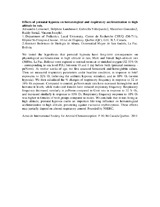Effects of prenatal hypoxia on hematological and respiratory acclimatization to high altitude in rats
Fecha
2011Autor
Lemoine, Alejandra Jochmans
Lumbroso, Delphine
Villalpando, Gabriela
Gonzales, Marcelino
Soria, Rudy
Joseph, Vincent
Metadatos
Mostrar el registro completo del ítemResumen
We tested the hypothesis that prenatal hypoxia have long-term consequences on
physiological acclimatization to high altitude in rats. Male and female high-altitude rats
(3600m, La Paz, Bolivia) were exposed to normal room air or enriched oxygen (32-35% O2
- corresponding to sea level PO2) between 10 and 1 day before birth (prenatal normoxia -
pnNorm). At twelve weeks of age, we first assessed hematocrit and hemoglobin values.
Then we measured respiratory parameters under baseline condition, in response to brief
exposures to 32% O2 (relieving the ambient hypoxic stimulus), and to 10% O2 (severe
hypoxia). We then calculated the % changes of respiratory frequency in response to 32 or
10% O2 exposure. Compared to control, pnNorm male rats have increased hemoglobin and
hematocrit levels, while males and females have reduced respiratory frequency. Respiratory
frequency decreased similarly in pnNorm compared to Cont rats in response to 32 % O2,
and increased similarly in response to 10% O2. Respiratory frequency response to 10% O2
was higher in females of both groups compared to males. We conclude that in rats living at
high altitude, prenatal hypoxia exerts an important life-long influence on hematological
acclimatization to high altitude, preventing against excessive erythrocytosis. These effects
may partially depend on altered respiratory control. Founded by NSERC.

